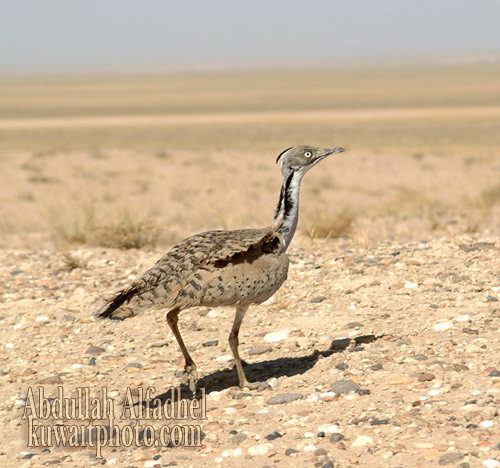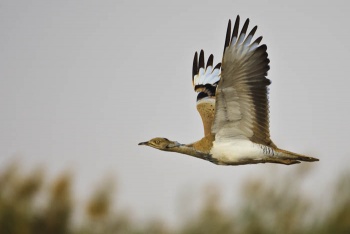(→External Links: New combined GSearch. GSearch checked template) |
|||
| (7 intermediate revisions by 5 users not shown) | |||
| Line 1: | Line 1: | ||
| − | + | [[Image:Macqueens_Bustard.jpg|thumb|550px|right|Photo by Kuwaity <br/>Photo taken: National Park, Sabiya, Kuwait ]] | |
| − | [[Image:Macqueens_Bustard.jpg|thumb|550px|right|Photo by Kuwaity]] | + | ;[[:Category:Chlamydotis|Chlamydotis]] macqueenii |
==Identification== | ==Identification== | ||
| − | + | 60 cm<br /> | |
| − | + | *Brown above | |
| − | + | *White below | |
| − | + | *Black stripe down the sides of neck<br /> | |
| − | + | Sexes are similar, but the female is smaller and greyer above. | |
| − | + | ==Distribution== | |
| − | == | + | Nile Valley of [[Egypt]] to [[Arabian Peninsula]] and [[Pakistan]]. |
| − | It | + | ====Vagrancy==== |
| + | MacQueen's Bustard has a greater tendency to wander than it's fellow ''Chlamydotis'' species, the sedentary Houbara Bustard. Records stretch as far as Great Britain, mainly in the 19th century, though only recorded as ''Chlamydotis'' bustards (pre-split, see Taxonomy). | ||
| + | [[Image:10V8547.jpg|thumb|350px|right|Photo by {{user|M.alkanderi|M.alkanderi}}<br />[[Kuwait]], November 2009]] | ||
| + | ====Population==== | ||
| + | It has been hunted to near-extinction in the Middle East by Arab falconers. Conservation efforts by the late Shaikh Zayed bin Sultan Al Nahyan in the United Arab Emirates have given some hope for the future of this bustard. | ||
==Taxonomy== | ==Taxonomy== | ||
| − | + | A monotypic species.<sup>[[#References|[1]]]</sup> | |
| − | |||
| − | + | Formerly lumped within [[Houbara Bustard]], ''C. undulata''. | |
==Habitat== | ==Habitat== | ||
| − | + | Deserts and very arid sandy areas. | |
==Behaviour== | ==Behaviour== | ||
| − | + | ====Breeding==== | |
| − | + | The 2-4 eggs are laid on the ground. | |
| − | + | ====Diet==== | |
| − | + | Diet includes seeds, insects and other small creatures. | |
| + | ==References== | ||
| + | #{{Ref-Clements6thDec08}}#Wikipedia | ||
| + | {{ref}} | ||
| + | ==External Links== | ||
| + | {{GSearch|"Chlamydotis macqueenii" {{!}} "Macqueen's Bustard"}} | ||
| + | {{GS-checked}}1 | ||
| + | <br /> | ||
| + | <br /> | ||
| − | + | [[Category:Birds]][[Category:Chlamydotis]] | |
| − | |||
| − | [[Category: | ||
Latest revision as of 23:07, 18 July 2023
- Chlamydotis macqueenii
Identification
60 cm
- Brown above
- White below
- Black stripe down the sides of neck
Sexes are similar, but the female is smaller and greyer above.
Distribution
Nile Valley of Egypt to Arabian Peninsula and Pakistan.
Vagrancy
MacQueen's Bustard has a greater tendency to wander than it's fellow Chlamydotis species, the sedentary Houbara Bustard. Records stretch as far as Great Britain, mainly in the 19th century, though only recorded as Chlamydotis bustards (pre-split, see Taxonomy).
Population
It has been hunted to near-extinction in the Middle East by Arab falconers. Conservation efforts by the late Shaikh Zayed bin Sultan Al Nahyan in the United Arab Emirates have given some hope for the future of this bustard.
Taxonomy
A monotypic species.[1]
Formerly lumped within Houbara Bustard, C. undulata.
Habitat
Deserts and very arid sandy areas.
Behaviour
Breeding
The 2-4 eggs are laid on the ground.
Diet
Diet includes seeds, insects and other small creatures.
References
- Clements, JF. 2008. The Clements Checklist of Birds of the World. 6th ed., with updates to December 2008. Ithaca: Cornell Univ. Press. ISBN 978-0801445019.
- Wikipedia
Recommended Citation
- BirdForum Opus contributors. (2024) Macqueen's Bustard. In: BirdForum, the forum for wild birds and birding. Retrieved 29 April 2024 from https://www.birdforum.net/opus/Macqueen%27s_Bustard
External Links
GSearch checked for 2020 platform.1





